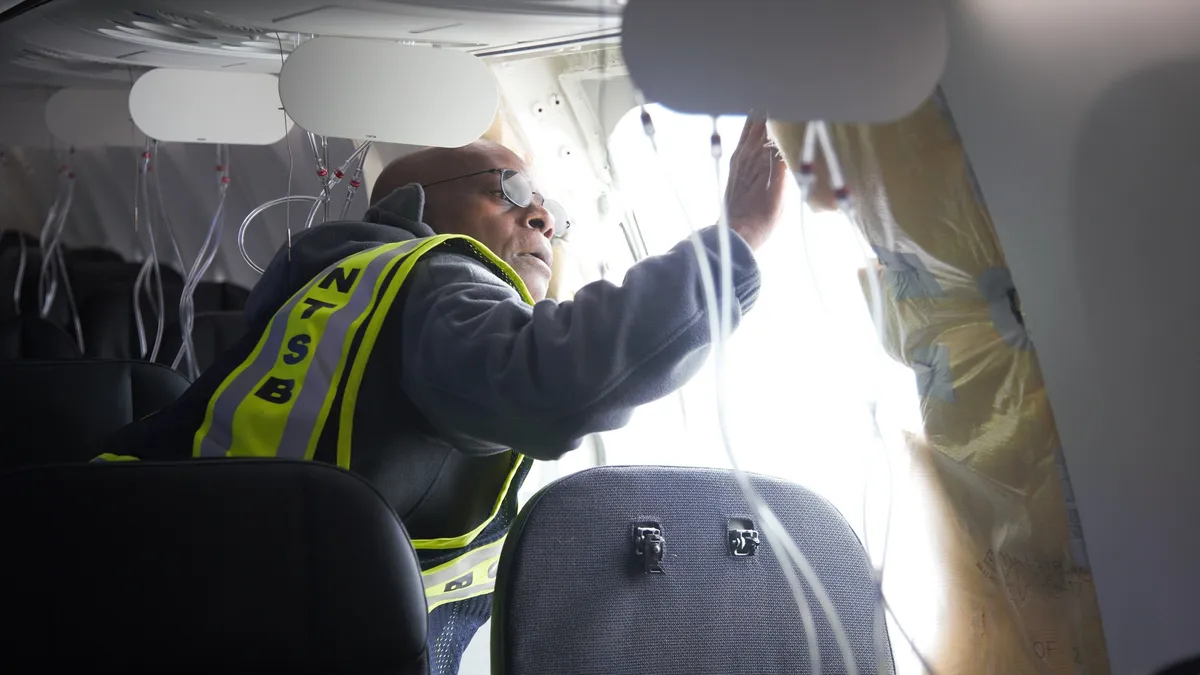Boeing’s production of 737 planes has temporarily slowed as the Federal Aviation Administration audits its operations, but it plans to ramp up to a production rate of 38 aircraft per month by the second half of the year, CFO Brian West said at an industry conference last week.
Speaking just over one month after a midair door plug blowout on one of its planes sent shock waves across the aerospace industry and beyond, West said the slowdown in production will allow the company to get the benefit of the audit and the company’s own inspection protocols.
“Right now we’re in the position where we have to do things like pause the line,” he noted, without offering specifics on current output, during a presentation at the TD Cowen Aerospace and Defense Conference in Arlington, Virginia. “I would fully expect us to move toward that 38 per month, but it will be dictated by the regulator.”
He also pledged to optimize the company’s supply chain by ensuring component production will not slow. The company also plans to close “shadow factories,” facilities where engineers fix problems in completed inventory, separate from those dedicated to producing new aircraft, he said.
The acknowledgment clarifies an earlier claim made by CEO Dave Calhoun on the company’s Jan. 31 fourth-quarter earnings call that Boeing was producing 737s at a rate of 38 per month.
“What I would only say is that the first half will be lower output, and the back half will be towards cycling to that 38 mostly because it's an uncertain moment,” West said at the conference, in response to a question from TD Cowen analyst Cai von Rumohr.
West’s presentation comes as the company is grappling with the implications of a Jan. 5 incident in which a door plug blew out of a Boeing 737-9 plane midair on an Alaska Airlines flight.
In the wake of the incident, the FAA announced an audit of manufacturing practices and production lines at Boeing and supplier Spirit AeroSystems. The FAA also ordered Boeing to limit production of 737s until safety concerns were addressed.
On a July 26 earnings call last year, Boeing’s CFO said the company’s goal was to reach 50 monthly 737 aircraft deliveries by 2025-2026, Industry Dive sister publication Manufacturing Dive reported.
But in early February, the company said it was reworking 50 undelivered 737 MAX jets after Spirit AeroSystems discovered misdrilled holes on some fuselages, Reuters reported.
Despite the pullback in aircraft production, the company plans to push for accelerated production of components by its suppliers, per its original schedule.
“We will keep the master schedule ahead of final assembly, and while we will still supplier by supplier maintain flexibility, our overall approach will be that we can avoid instability and broad movements in the supply chain by holding supplier build rates pretty steady,” he said. “If that means we have to hold more inventory, we'll do that,” he added, noting that the company has the cash flow to support the ramp-up in component production.
Shadow factories
Shadow factories, or facilities set up to find and fix problems on already-constructed inventory, continue to be a drain on the company’s margins. On the company’s fourth-quarter earnings call, Calhoun said the company puts more hours into shadow factories than it does to produce aircraft in the first place.
West, on Tuesday, said the company is on a path to close the 787 model shadow factory, which will allow it to move labor from reworking airplanes to working on new production.
The cost of an airplane is 60% to 70% of parts, with labor less than 15%, he said. Closing shadow factories will help optimize the supply chain once the dust settles after current turmoil.
“We still believe that once we get through what's in front of us, we get to a point where we have stability. You [will] have a 737 and 787 that look different and better than what they're at today,” said West.
A Feb. 9 Jefferies report, citing Jon Ostrower of industry publication The Air Current, stated that the company’s outlook is uncertain given enhanced oversight from regulators and supply chain issues.
“In addition to the heightened regulatory scrutiny, Boeing's customers are very frustrated with the serial quality failures and continued production schedule delays, which are preventing the delivery of contractually agreed upon aircraft,” Ostrower stated. “No one can say with any degree of certainty what the [2025-2026] production outlook is despite massive demand from airlines and an industrial system.”






















